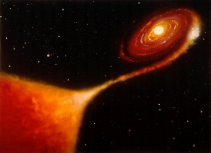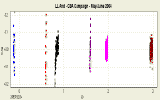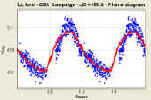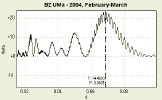 |
 |
|
Peranso

Powerful
software for Variable Star Light Curve
Analysis, offering a variety of period
analysis methods www.peranso.com
|
|
 |
| |
|
 |
 |
 |
 |
|
 |
| |
Cataclysmic
Variables
More
than half of the stars in our Galaxy are not
single stars like our Sun, but occur in binary or
multiple systems. If two stars come close enough together without actually colliding, they may "capture" each other and become gravitationally bound.
| One type of binary that might form this way is a "cataclysmic
variable" (CV), a pairing of a normal, hydrogen-burning star and a burned-out star called a white dwarf.
The white dwarf will pull material off the surface of the normal star. This material encircles the white dwarf in an "accretion disk," and eventually falls onto it. |
|
 |
| The result of this accretion process is that
CVs are, as the name suggests, variable in brightness. |
|
Artist
view of a cataclysmic variable. Artist Credit: Dana Berry |
| I'm
studying,
through time-series CCD photometry, this particularly interesting group of variable
stars, as an active member of the Center for Backyard Astrophysics,
headed by Columbia University professor Joe Patterson. I find CVs
intriguing, because they provide a
unique laboratory for the study of two fundamental astrophysical processes:
accretion and binary star evolution. |
Important
observations made in 2008
Observations prior
to 2008
Use
the navigation bar (upper left) for an overview of
my cataclysmic variable star observations prior to
2008.
Publications
I'm
author and co-author of an extensive set of articles
on cataclysmic variables.





|
|
 |
|
 |
|